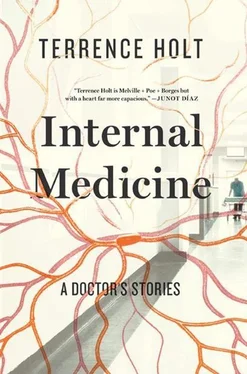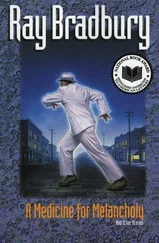She was asking about the continuous telemetry of the patient’s EKG. “Nothing significant.”
“Okay,” she said, jerking her thumb upward. “Get cranking. She’s losing ground here.”
And so we moved on to the next patient, and by one p.m. I had signed out to the on-call intern that Marie was to be a liter negative by morning, and if not to hit her with an extra 120 IV at four a.m., but to watch her K.
The next morning we were on call again. I spent the half hour before rounds checking up on the three patients I was carrying going into call. I left Marie to last, my reluctance to enter her room being by this time nearly insuperable. In response to my usual question, she gave her usual answer. “Terrible. I feel so weak, Doctor. Just so weak and shaky.” She said this in her usual tremulous voice, waving the back of her hand over her face to express her weakness. I couldn’t help but notice, uncharitably, her breakfast tray, every bowl and plate stripped clean to the last sheen of grease. Her vital signs were stable, and her urine output had indeed picked up: not the entire liter we had hoped for, but most of it. It was with a feeling of hope — I might discharge her soon — that I left her room for a last check of labs before rounds.
But what I saw in the labs wasn’t good. Overnight, Marie’s serum creatinine — the general indicator of the kidney’s ability to clear wastes — had almost doubled. Worse, her potassium — the “K” I had asked the intern to watch — was over six. The number was highlighted on the screen in red. We watch potassium generally in hospitalized patients: it’s a critical element, its level easily perturbed, and too wide a deviation can throw the heart’s rhythm awry. A patient on dobutamine with a potassium greater than six was not something I wanted to present on rounds. I had three minutes to find a nurse and order the four different things that would take care of this. As I was scribbling the orders on the chart, somewhere in the back of my head I was processing the other half of this story, the one I could do nothing about. Her heart was overloaded with fluid her kidneys could no longer expel. And now, under the burden of her failing heart, her kidneys were beginning to fail as well.
I was a minute late for the start of rounds.
As another long day of call ground into motion, I carried with me through the morning’s rituals a bleak sensation of change about to happen. Or perhaps, with the shift of a few numbers on a computer display, it already had, crossing over from the well-worn track Marie’s history had followed so faithfully for so long, to the other routine that plots the hospital’s daily round, the inexorable slippage into death. Marie’s electrolyte abnormality was significant not because it put her at risk of sudden death (although it did). The real significance was that the routine tune-up was over. Our only means of lightening the load on Marie’s heart had failed. This much, at least, had become brutally clear by rounds the next morning, even after another sleepless night.
When we reached her doorway I presented the data, and ground to a halt. I had no idea what came next.
The attending turned to the fellow.
“Now what?”
The fellow tugged at his lower lip. “I think we need to Swann her.”
The attending nodded. The fellow turned to me and said, “Move her to the Unit. We’ll Swann her after rounds.”
My legs sagged. I’d been up all night — all month, it seemed — and it was now ten forty-five; we’d been rounding since eight, and still had seven patients to see. It would be a miracle if we finished by noon. I wanted to go home, of course. I wanted to sleep, to stop thinking, more than anything else to stop thinking about Marie P. Beyond that, I hated the Swann. I hated the Swann because it takes at least an hour to set up, and hours more to thread a catheter into the jugular, through the heart, and into the lung. And then the fellow wants to spend hours more taking readings, before finally some decision emerges from the procedure, one I would be responsible for acting upon. I didn’t want to hang around to run scut afterward. Marie was just supposed to be a tune-up. She wasn’t supposed to take this much time.
It fell to me, as the resident, to float the Swann. Sometime around one p.m., the hour when, after a night on my feet, my higher functions start to wink out like so many overused lamps, I stood at the head of Marie’s new bed in the CCU, hieratically gowned and masked. Marie herself had disappeared under a wad of sterile green towels (it had required four milligrams of Ativan to get her to hold still for this), from which her tiny, rhythmic snores could be heard.
As I approached her neck with a four-inch needle, the landmarks by which I was supposed to find the internal jugular vein were awash in flesh, but I was lucky, and on the first pass an abrupt flash of blood swirled into the barrel of the syringe in deep purple arabesques. “Got it,” I announced. The fellow, whose customary moroseness had taken on an overlay of anxiety, rattled out unnecessary advice. “Hold your finger over the hub, that’s it, don’t lose it, now advance the wire, good,” rising in volume and frequency as the nurse on my right fed me a long, skinny tube, which I advanced into Marie’s neck. This went on for some time, until the fellow barked, “Stop. We got a wedge.”
“That’s a wedge?” The nurse, with fifteen years’ experience on him, sounded skeptical. I was content to stare at the ceiling, wishing I could scratch my nose. The rest of their back-and-forth floated past me like smoke. I picked out only the words I wanted to hear, the ones, finally, that meant my part was done: I slumped against the wall and peeled off my gloves. They talked on. The patient snored. With any luck I could be home by dinner.
Early the next morning I was back, studying the numbers the Swann had generated. They filled up Marie’s flow sheet. On the floor, where vital signs are checked perhaps once a shift, a patient’s flow sheet can fit a week’s records to a page. On the Unit, a single day’s sheet is a foldout thirty-four inches long, a grid with boxes dedicated to every physical parameter of human existence. Marie’s that day was dark with ink.
The section I was studying held numbers that were supposed to reveal Marie’s fate: cardiac output, cardiac index, left ventricular end-diastolic pressure, systemic vascular resistance. These were why we had put her through that exercise, but as I scanned the numbers back and forth, they told me nothing.
Not that I am an expert in the interpretation of Swann-Ganz catheter readings. We were getting into territory where I was clearly little more than a collector of information. But I knew enough to see that the numbers we were getting didn’t add up. If, three weeks into this rotation, I still knew how to add. If I still knew how to care.
“We see this sometimes,” the attending explained. “In the end stage everything just falls apart.”
“But what does it mean?” the fellow asked, waving the flow sheet. I was gratified to hear confusion in his voice, too.
The attending shrugged. “It means she’s falling apart. The physiology just isn’t there anymore.”
There was a long silence, during which the stately puffing of a ventilator in a nearby room became more and more distinct.
“So what’s keeping her alive?” I asked.
The attending turned to look at me. “Nothing,” she said flatly.
I HAVE A CLEAR MEMORY from this period, although what day exactly this might have happened I no longer recall, of the attending emerging from Marie’s room and stopping to brush at her eye before sitting to write in the chart. I remember it so vividly, like something glimpsed from a speeding train, because at the time it had no meaning. I could make no sense of it. It may not have happened at all. After three weeks of q3 call, dream and memory had become indistinct, the one unwelcome as a distraction from sleep, the other unwelcome always, the dead and discharged claiming time beyond any I had to give.
Читать дальше












